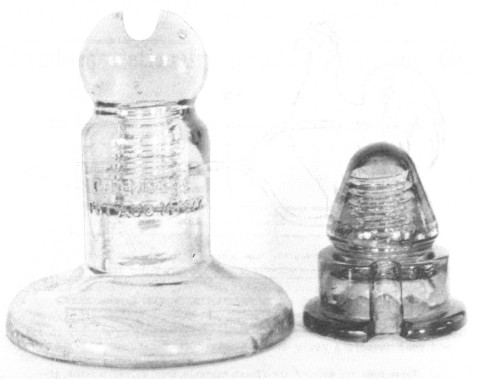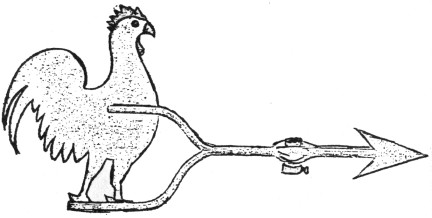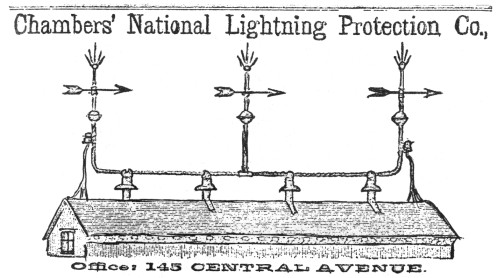Patent Pages
by Ray Klingensmith
Reprinted from "INSULATORS - Crown Jewels of the Wire", September 1978, page 7
CHAMBERS AND HIS INSULATORS - PART II
Last month we covered Josephus Chambers' business activities and a little on
his insulators. The first insulator he used, that we are familiar with, was more
than likely the CD 317. This is a rather large insulator, measuring
approximately 7 inches wide and 7 1/2 inches tall. See photo below for a front
view of this item. It was designed to be used on the roofs of buildings to hold the "lightning rod" which
ran parallel to the top of the roof. The insulator remained dry on the interior
during a rain or in damp weather. This particular insulator is known in aqua,
deep aqua, lime green, smoky grey, medium green and blue. I saw the blue one two
or three years ago. It seems to me it was a cornflower blue similar to the blue
Duquesnes.

The CD 317 Chambers, medium aqua, and the CD 132.4 in dark aqua.
Notice the
groove in the skirt of the CD 132.4 which held the "riser".
|

Our Arrows are covered with pure gold leaf and electro-plated, end are
warranted to keep bright for many years. These arrows slip down on the rod, and
are fastened with a thumb-screw to the rod. We cover no points or ornaments of
any kind with bronze, but cover them with pure gold leaf, silver plate, or the
best electro plates, as may he desired.

No 6 is Weather Vane covered with pure gold leaf.

These Rods are made of the finest magnetic iron, spiral twisted, giving them
a beautiful appearance on a building. They are galvanized with the best German
spelter. It Is impossible to give the rod such a bright and lustrous appearance
with any other material.
The best lightning rod is always the cheapest. All the
telegraph companies have long since learned that a raw iron wire would soon
corrode, and hence would not conduct electricity, and they have therefore
substituted galvanized iron wire in all parts of the world. This we consider a
practical test, and one that speaks volumes for galvanized rods.
|
A page from a Chambers catalogue, offering lightning rod
equipment.
There was also another type produced which is similar in appearance
to the CD 317. It was meant to be used in the same manner. It is the CD 317.5
and is found in aqua glass. Another type was produced to be used as a
"companion" to the above mentioned items. It was designed to hold that
part of the rod which pointed into the air to receive or "throw off"
the electrical charge. (Chambers' theory was that the lightning would strike a
riser at one end of the building, travel along the rod to the other end, where
it would exit through another riser, and dissipate into the air. All which seems
very interesting.)
There were at least two types designed to hold the riser. The CD 132.4 is
shown in the photo with the CD 317. It was used more commonly than that of
another style designed for the same purpose, that being the CD 124.5. The CD
132.4 is found in aqua, deep aqua, and bubbly light aqua. It looks very much
like a CD 132 "Hemingray" (1871 patent dated item). In fact, a mold
used to make the CD 132 may have been "reworked' to manufacture the CD
132.4 Chambers. The CD 124.5, which is the rarest of the four known styles is an
interesting little jewel. There are very few of these around.

Part of Chambers' ad appearing in the 1882 Cincinnati Business
Directory, showing the "Chambers System".
This gives a clearer idea how the insulators were used.
The CD 132.4 and CD 124.5 were used on the stand that appears at the ends of
the building. The CD 124.5 may also have been made in a "reworked"
mold. At least one of these items had part of a "4" remaining on the
dome, which indicated that a mold which had been used to make the No 4 style (CD
124.3) was changed to supply Chambers with the CD 124.5. Hemingray made all four
styles for Chambers. (1871 date, a patent issued to Hemingray, appears on all
these items.) These insulators are all interesting styles, and make a welcome
addition to any collection.
That's all for this month. Thanks to Glenn Drummond for supplying so much
info for these two articles, and to Mike Johnson for allowing his CD 132.4 to be
photographed. Happy Collecting.
|
